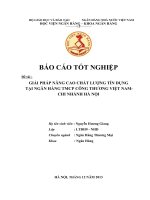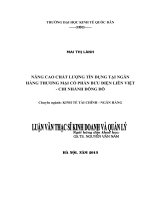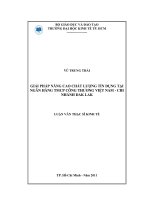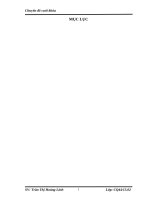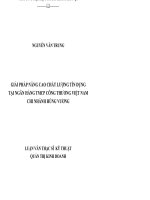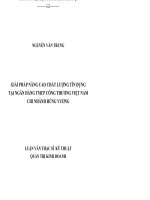GIẢI PHÁP NÂNG CAO CHẤT LƯỢNG tín DỤNG tại NGÂN HÀNG TMCP dầu KHÍ TOÀN cầu CHI NHÁNH ĐÔNG đô e
Bạn đang xem bản rút gọn của tài liệu. Xem và tải ngay bản đầy đủ của tài liệu tại đây (1.1 MB, 75 trang )
INTERNATIONAL EXECUTIVE
MASTER OF BUSINESS ADMINISTRATION PROGRAM
THESIS MBA
“SOLUTIONS TO IMPROVE CREDIT
QUALITY AT TOAN CAU OIL & GAS JOINT STOCK
COMMERCIAL BANK - DONG DO BRANCH”
DECLARATION OF AUTHORSHIP
HANOI, JULY- 2013
I declare that the thesis is my own work and have been generated by me, all the
data and results in the thesis is clearly attributed.
I state all the confirmation.
2
ABBREVIATIONS
GP.Bank:
Global Petro Bank
PGD:
Branch
TMCP:
Commercial Joint stock
TCTD:
Credit agencies
NHTM:
Commercial Bank
NHNN:
State Bank
HĐQT:
Board of Management (BOM)
CNH-HĐH:
Industrialization, modernization
TNHH:
Limited company
Thuế VAT:
Value added tax
CIC:
Centre for Information Credit
KTXH:
Economical Social
NQH:
Overdue debt.
Thẻ ATM:
Automated Teller Machine
CBNV:
Staff
TABLE OF CONTENT
3
OPENING.................................................................................................................9
1. The necessity of thesis........................................................................................9
2. Aims of the thesis.............................................................................................10
3. Source materials and scope of study.................................................................10
4. Methodology....................................................................................................11
5. Structure...........................................................................................................11
Chapter I: General Introduction...............................................................................11
1. 1. Concept of corporate strategy.......................................................................11
1.1.1.Concept of strategy..................................................................................11
1.1.2. The role of strategy.................................................................................13
1.2. External environment analysis......................................................................14
1.2.1. Macro environment analysis (PEST analysis).........................................14
1.2.1.1. Political Analysis..............................................................................14
1.2.1.2. Economic Analysis...........................................................................15
1.2.1.3. Social Analysis.................................................................................15
1.2.1.4. Technological Analysis.....................................................................16
1.2.2. Industry analysis (5 forces of Michael Porter)........................................16
1.2.2.1. Supplier Power.................................................................................16
1.2.2.2. Buyer Power.....................................................................................16
1.2.2.3. Barriers to entry................................................................................17
1.2.2.4. Competitive Rivalry..........................................................................18
4
1.2.2.5. Threats of substitutes........................................................................18
1.3. Micro environment analysis..........................................................................18
1.4. Basic concept of banking credit....................................................................18
1.4.1. Concept and features of banking credit...................................................18
1.4.2. Types of banking credit...........................................................................19
1.4.3. Roles of banking credit...........................................................................21
1.5. Theory of banking credit quality...................................................................23
1.5.1. Concept of banking credit quality...........................................................23
1.5.2. Indicators of banking credit quality.........................................................24
1.5.2.1.Qualitative indicators.........................................................................24
1.5.2.2. Quantitative indicators......................................................................25
1.5.3. Factors that affect banking credit quality................................................28
1.5.3.1. Factors from customers.....................................................................28
1.5.3.2. Factors from banks...........................................................................30
1.5.3.3. Business environment.......................................................................33
Chapter 2: The situation of credit quality at GP Bank - Dong Do Branch...............34
2.1. Overview of GP bank-Dong Do Branch........................................................34
2.1.1.History and development.........................................................................34
2.1.2. Network..................................................................................................35
2.1.3. Function and mission..............................................................................36
2.1.3.1. Director.............................................................................................36
5
2.1.3.2. Vice directors....................................................................................36
2.1.3.3. Departments and transaction offices.................................................37
2.1.3.4. Board of Credit.................................................................................39
2.1.4. Function and mission of Dong Do Branch in GP Bank network.............39
2.2. The business profile of Global petro bank - Dong Do Branch in the recent years
............................................................................................................................. 40
2.2.1. Capital mobilization................................................................................40
2.2.2. Lending and capital investment...............................................................41
2.2.3. Services...................................................................................................42
2.2.4. Business results.......................................................................................43
2.2.5. The situation of credit quality.................................................................44
2.2.5.1. Some regulations about credit activities...........................................44
2.2.5.2. Credit quality....................................................................................46
2.3. Analyse the business environment at GP Bank - Dong Do Branch...............54
2.3.1. Macroenvironment (PEST++).................................................................54
2.3.1.1. Economic Analysis...........................................................................54
2.3.1.2. Political Analysis..............................................................................55
2.3.1.3. Cuture – socio analysis.....................................................................55
2.3.1.4. Technology analysis..........................................................................56
2.3.2. Industry analysis.....................................................................................56
2.3.2.1. Buyer power.....................................................................................56
6
2.3.2.2. Supplier Power.................................................................................58
2.3.2.3. Competitive Rivalry..........................................................................59
2.3.2.4. Barriers to entry................................................................................59
2.3.2.5. Threats of subsitutes.........................................................................60
2.3.4. Opportunities and threats.....................................................................61
2.4. Micro environment analysis at Dong Do Branch..........................................62
2.4.1. Human resource analysis........................................................................62
2.4.1.1. Human resource................................................................................62
2.4.1.2. Finance.............................................................................................63
2.4.1.3. Technical facility..............................................................................63
2.4.1.4. Technology.......................................................................................63
2.4.2. Strengths, Weaknesses (S,W)..................................................................64
Chapter 3: CONCLUSION AND SOLUTIONS TO IMPROVE THE CREDIT QUALITY
AT GP BANK - DONG DO BRANCH...................................................................65
3.1. Conclusions from the case of credit quality at GP Bank - Dong Do Branch
65
3.1.1. Achievements..........................................................................................65
3.1.2. Limitations..............................................................................................66
3.1.3. Causes.....................................................................................................67
3.2. The oriented activities of credit in GP bank - Dong Do Branch....................69
3.2.1. The orientation to develop the credit activity at Dong Do Branch..........69
7
3.2.2. Expected results......................................................................................70
3.3. Some solutions to improve the credit quality of GP Bank - Dong Do Branch71
3.3.1. Capital mobilization to improve credit quality........................................71
3.3.2. Improving credit policies contribute to the credit quality improvement
71
3.3.3. Diversification of the customer, reasonable customer strategy...............72
3.3.4. Complete the credit process....................................................................73
3.3.4.1. Analyse, evaluate accurately customers:...........................................73
3.3.4.2. Improving the quality of evaluation..................................................73
3.2.4.3. Lending decisions must be based on identifying and understanding the
borrower. 74
3.3.4.4. Building inspection systems, credit monitoring performance:..........75
3.3.4.5. Strengthening the debt management and overdue debt settlement....75
3.4.5. Differences to compete...........................................................................76
3.3.6. Other solutions........................................................................................77
3.3.6.1. Maketing strategy..............................................................................77
3.3.6.2. Develop and use reasonable use of reserve fund...............................78
3.3.6.3. Supervising and monitoring..............................................................78
3.3.6.4. Moderization to improve credit quality.............................................79
3.3.6.5. Information of customers..................................................................79
REFERENCES........................................................................................................79
8
LISTS OF TABLE AND CHARTS
Chart2.1.Organization structure of GP Bank - Đông Đô Branch…………………………36
Table 2.1: Debt financing situation..........................................................................40
Table 2.2: The lending and debt collection situation
9
42
Table2.3: Business activiy result
43
Chart 2.1: The short term, middle and long term credit structure............................47
Chart 2.2: Economic classification structure...........................................................48
Chart 2.3: Pledged asset classification credit structure............................................49
Table 2.5: Outstanding overdue debt.......................................................................50
Đồ thị 2.4: The overdue debt ratio at branch...........................................................50
Table 2.6: Overdue debt classification.....................................................................50
Table 2.7: Credit cycle.............................................................................................52
Table 2.8: Incremental Capital Output Ratio...........................................................53
table 2.9 : Revenue from credit activity...................................................................53
Chart 2.5: Revenue from credit activity shown by chart..........................................53
10
OPENING
1. The necessity of thesis:
The world economy situation in the first 6 months of 2013 is shown by the
recovery of the U.S. economy with many bright spots along with the decline in
unemployment rate, the housing and land market improved monthly, the confidence of
consumer peaked the highest in past 6 years. Besides Japanese launched the largest
stimulation campaign ever, Japan State bank pumped an amount of money into the
economy. The monthly basis money in
June 2013 increased 36% compared to the
previous year. The Yen broke the 100 yen / dollar landmark, creating favorable conditions
for exporter. The economy thrived thanks to Abenomics. Besides, China's economy has
many uncertainties, there appears the lack of cash. The European economy has not got out
of the crisis, although the European Central Bank has reduced interest rates.
The country's economy in the first 6 months of 2013 took place when the world
was still affected by the economy depression, global finance, especially in the Euro area.
Some countries have adjusted reduction in the growth rate of the year. The market
consumption is narrow leads to the decline in consumer ‘s demand. In domestic, although
some macroeconomic balances have improved in the late 2012 and early 2013, but the
business activities of enterprises face a lot of difficulties and challenges. Inventories are
high, many businesses shut down or dissolved in 2012 and early 2013. Bad debt situation
has not been resolved ... Under these circumstances, January 7th 2013, the Government
issued Resolution No. 01/NQ-CP on the key measures to direction and implementation of
the economic-social and budget state development plan, as well as the Resolution No.
02/NQ-CP about some solutions to solve difficulties for business, marketing assistance,
bad debt resolve, while direct the implementation drastically all sectors, local to achieve
the economic social goals of the year. Thus, the economy picture in the first 6 months of
the country basically has some positive changes, but there still exists many difficulties and
shortcomings.
The credit growth target in 2013 is 12%, but in the end of June, the whole new
banking system grew by 4.5%. Accordingly, the pressure of the credit growth in the last
months are weighing on many commercial banks. Based on the Government regular
11
meeting report in July, the credit growth of the banking system at the point of July 25th
was estimated to increase 5.02%. But according to the central bank, at the end of July 24th,
the total customer deposits at commercial banks rose 9.48% and the estimated credit
growth for the economy is only 4.91%.
Meanwhile, from now till the end of the year, the credit growth must be 1.4%
/month in average to get the target of 12%. However, after more than 6 months, some
banks in the system such as Sacombank, NamA Bank achieved 12%. It showed that the
credit growth at commercial banks was gloomy, Vietcombank even gained negative 1%.
In addition, the credit growth of commercial banks mostly rely on consumer loans,
business credit remains very low. Currently, banks are no longer race on interest rates to
attract capital but on many preferential-rate credit services. Accordingly, for individual
customers, commercial banks boost consumer loans, buy cars, buy or build home... rates
are quite reasonable.
2. Aims of the thesis:
The thesis focuses on the following content:
- The basic theory of business strategy, credit activities in commercial banks.
- Analyzing the real situation of credit quality at Gas Petro Bank - Dong Do branch,
evaluating causes and drawing lessons.
- Proposing solutions to improve credit quality at GP Bank - Dong Do branch in the
near future.
3. Source materials and scope of study:
3.1.Source materials:
The thesis studies the credit quality at Gas Petro Bank - Dong Do branch.
3.2. Scope:
The thesis studies the credit quality at Gas Petro Bank - Dong Do branch in the
period of 2009 - 2011, proposes solutions to improve credit quality until 2015.
4. Methodology:
Using analytical methods, statistical methods, methods of synthesis and
comparative approach to study..
12
5. Structure of study:
To achieve its aim, the study will obey the following structure.
Chapter 1: General Introduction
Chapter 2: Credit quality situation at GP Bank – Dong Do Branch
Chapter 3: Conclusion and some solutions to improve the credit quality at GP bank
– Dong Do Branch
Chapter 1: GENERAL INTRODUCTION
1. 1. Definition of corporate strategy
1.1.1.Definition of strategy
Strategy is the art of the general, the guide and tool to achieve an identified goal.
According to Alfred D. Chandler “strategy is the determination of the basic longterm goals and objectives of an enterprise and the adoption of the courses of action and the
allocation of resources necessary for carrying out these goals.”
William J. Glueck defines the term strategy as “the unified, comprehensive and
integrated plan that relates the strategic advantage of the firm and is designed to ensure
that the basic objectives of the enterprise are achieved through implementation process”.
In “the concept of strategic management” Fried R. David wrote: Strategy is the
mean to reach long-term objectives. Business strategies may include geographic growth,
diversification of activities, property, product development, market penetration, cutting
spending, liquidation and joint venture.
Strategy is also a method of describing the future position of a company, its
objectives, purposes, goals, policies, and plans that may be required for guiding the company from
its existing position to where it desires to be. Moreover, competitive strategy or corporate strategy is
also defined under 6 following factors:
- Product Markets: Opportunity of a business depends on its products, market, the
competition that it can confront or avoid as well as the degree of its integration.
- Level of investment: A business should select the ability to expand or enter the product
13
market to maintain the current position, or minimize investment to withdrawal or liquidate
to dissolve the business.
- Strategic function: The competition can be one of following functions: product strategy,
strategic position, pricing strategy, distribution strategy, manufacturing strategy,
information
technology
strategy,
segmentation,
globalization.
- Asset strategy and capability strategy: capability strategy is the dominant aspect of the
business. Asset strategy is the competitive power of resources advantages. When making
strategic plan, a business should focus on the costs as well as asset maintainance and
creation, the capabilities as the foundation for a long-term competitive advantage of
enterprises.
- The allocation of resources: Financial and non-financial resources such as buildings,
equipment, people have to be all allocated. Allocation decision is a key factor for a
strategy.
- Corporation effects between enterprises: Only enterprises corporated each others reach
superior advantages compared to those who ignored or exploited this level of effect.
In general, strategy is a set of actions and decisions which are closely related to each
other, helps the organization achieve its objectives. It is constructed to take advantages of
the strengths including the resources of the organization as well as to consider the
opportunities and challenges of the environment.
1.1.2. The role of strategy
- Strategies provide the framework for plans by channeling operating decisions and often
pre-deciding them. They make the organizational objectives more clear and specific. Each
resource of the organization has a specific use at a particular time. Thus, strategies ensure
that resources are put in action in a way in which these have been specified. If this is done,
organization will achieve effectiveness in long-term.
- Corporate strategy is to help business understanding and taking advantages of
business opportunities, and proactive in overcoming the risks and threats in the
marketcompetition.
- Corporate Strategy contributes to the efficiency of resource use improvement,
14
enhances the competitive position, ensures the sustainable development of
enterprises.
- Corporate strategy: creates a solid basis for the formulation of policy and decision about
production in line with market fluctuations. It provides a solid basis for research and
development, investment in developing personnel training, market expansion activities
and product development. In fact most of the mistakes in investment, technology, markets
... are derived from place strategy or bias in determining the strategic objectives.
The source of success or failure depends on an important factor “how the enterprise
business strategy is”.
- Planning: corporate strategy helps business finding its purpose and direction, the
manager knows what to consider and determine the organization and when he can achieve
the objectives.
- Forecasting: In a convulsed environment, the risks and opportunities always emerge,
strategic planning helps managers analyze the environment, make predictions for a right
direction, so that managers have the ability to capture and make better use of opportunities
and
reducing
risks
related
to
the
environment.
- Control: Corporate strategies helps managers use and allocate available resources in an
optimal way, as well as coordinate effectively functions in the organization to achieve
objectives.
1.2. External environment analysis
As these factors, forces, substitutions... outside the company which the managers can not
control but affect the operations and results of operations of the Company.
1.2.1. Macro environment analysis (PEST)
Macro environment includes: Economic, political, technological, cultural-social, natural
factors.
1.2.1.1. Political analysis.
Factors are basically to what degree the government intervenes in the economy.
When doing business in a country, we have to follow and apply its legal policy
15
+ Stability: We will consider the stability among factors such as: political conflict,
foreign legal institutions. Institutions that have high stability can create good conditions
for business operations, reversely it will be instability, confliction will have bad impact on
business activities on its territory.
+ Tax policy : export- import tax, sales tax, income tax ... will affect revenue and
profitability of the business.
+ Regulations and law: investment law, entrepreneur law, labour law, anti-monololy
law, anti-dumping law ...
+ Policy: The policy of the state will have an impact on business, it can make profit
or business challenges. Such as the trade policy, development policy, economic
development, tax, and regulated competition policy, consumer protection ...
1.2.1.2. Economic Analysis
Enterprises should pay attention to the economic factors in the short-term, longterm and government intervention on the economy.
Economic factors affect the purchasing power of potential customers and the firm's
cost of capital. The following are examples of factors in the macroeconomy: economic
growth, interest rates, exchange rates, inflation rate
+ The economic policy of the government: the basic wage law, the economic
development strategy of the government, the incentives for the industry: tax breaks,
subsidies
....
+ The economic outlook in the future: growth, increase GDP, GDP ratio on
investment ...
1.2.1.3. Social Analysis
Cultural values make society. It fosters the existence and development of a society.
Therefore, cultural factors are generally very protective, especially the spiritual culture.
16
Social factors include the demographic and cultural aspects of the external
macroenvironment. These factors affect customer needs and the size of potential markets.
Some social factors include: health consciousness, population growth rate, age
distribution, career attitudes, emphasis on safety, lifestyle, living condition…
1.2.1.4. Technological Analysis
In the world of technology revolution, a series of new technology was launched and
integrated into products and services. If 30 years ago, a computer is just a tool to calculate,
now it has functions to replace a man working completely independent. Especially in the
field of information technology, modern communications technology has shortened the
geographical distance, transmission media.
Technological factors can lower barriers to entry, reduce minimum efficient
production levels, and influence outsourcing decisions. Some technological factors
include: R&D activity, automation, technology incentives, rate of technological change
1.2.2. Industry analysis (5 forces of M. Porter)
Porter’s Five Forces is first published on Harvard Business Review in 1979 with the
content of finding the factors that make profit for business. This model is usually called “
5 forces of Porter”, which is known as an effective and useful tool to find the root of
profit. Moreover, it shows the competitive strategy to maintain or increase profit of a
business.
1.2.2.1. Supplier power
The bargaining power of suppliers is also described as the market of inputs.
Suppliers of raw materials, components, labor, and services (such as expertise) to the firm
can be a source of power over the firm, when there are few substitutes. Suppliers may
refuse to work with the firm, charge excessively high prices for unique resources.
-
Number of suppliers: determines the forces, negotiation to the field and enterprise.
17
-
Supplier switching costs relative to firm switching costs
-
Information of suppliers: Strength of distribution channel…
1.2.2.2. Buyer Power
Buyers/customers are those who can affect directly to the business activity. It is
identified in 2 groups:
+Retailers
+Distributors
These two groups put pressure on the enterprise in pricing, product quality,
knowledge of suppliers' costs considerably increases the bargaining position of buyers.
There are a number of factors which increase the power buyers:
+ Scale
+Importance
+Buyer switching costs
+Information of buyers
1.2.2.3. Barriers to entry
The possibility of new firms entering the industry impacts competition. A key is to assess
how easy it is for a new player to enter an industry. The most attractive segment has high
entry barriers and low exit barriers.
Barriers to entry are unique characteristics to each industry. They reduce the rate of
entry of new firms and, therefore, maintain a level of profits for current industry
competitors. Barriers to entry can be created or exploited to enhance a firm’s competitive
advantage.
Barriers to entry arise from several sources:
- Patents and proprietary knowledge
- Asset specificity – (Specialized technology or infrastructure)
- Economies of scale
- Government, stakeholders
18
Exit barriers limit the ability of a firm to leave the market and can exacerbate rivalry –
unable to leave the industry, a firm must compete.
1.2.2.4. Competitive rivalry
According to M.Porter, rivalry refers to the competitive struggle for market share between
firms in an industry. Extreme rivalry among established firms poses a strong threat to
profitability. The strength of rivalry among established firms within an industry is a
function of following factors:
+ Extent of exit barriers, amount of fixed cost, competitive structure of industry, presence
of global customers, absence of switching costs, growth Rate of industry, demand
conditions
+ Barriers of joining field: technology, capital, commercial factors: distribution system,
customer system, trademark, material, copyright, Government protection….
1.2.2.5. Threats of substitutes
Substitute products refer to the products having ability of satisfying customers needs
effectively. A threat of substitutes exists when a product's demand is affected by the price
change of a substitute product: more substitutes become available, the demand becomes
more elastic since customers have more alternatives.
1.3. Micro environment analysis
A micro-environmental analysis is a review of the internal climate of a business. The
review typically covers all aspects that are under the operating control of the business.
Services or products a company manufactures or provides, operational decisions, and
marketing activities are assessed and analyzed in a micro-environmental analysis.
Micro-environmental analysis is to find out the strengths and weaknesses of the
business, to find ways to achieve competitive advantage, the role of different capacities,
resources to maintain a sustainable competitive advantage.
1.4. Basic concept of banking credit
1.4.1. Concept and features of banking credit
19
It s difficult to define clearly what credit is, based on each study, we can give out
different definition for this term.
Credit is derived from a Latin word “caredo” (means belief, trust). In fact, credit can
be understanded in many meanings. Even in finance, depends on each circumstance to
defind the concept.
Credit is a basic function in banking activity and it can be defined as followed:
Credit is a asset transaction which allows one party to provide resources (financial, goods,
or service) to another party(corporation, individuals) where that second party does not
reimburse the first party immediately (thereby generating a debt), but instead arranges
either to repay or return those resources (or other materials of equal value) at a later date.
1.4.2. Types of banking credit
To
manage
and
effectively
use
credit,
it
is
necessary
to
classify.
Classification is the arrangement of loans in groups based on a certain number of criteria,
if the loan is classified basically, banks can establish appropriate procedures for loans as
well
as
improve
the
efficiency
and
management
of
credit
risk.
There are many types of loan, but in fact it is often classified as the lending criteria as
below:
* Based on the purposes, there are types of loans:
- Loan for corporation: Finance is provided to meet the demand of capital, costs in
industry, commerce and service.
- Loan for real estate: Loan is given for the investment in industrial infrastructure,
urban areas, house for rent or for sell.
- Loan for agriculture: Finance is provided to meet out manufacture costs such as
fertilizer, pesticides, seeds, animal food, labour, materials…
- Loan for import-export: Loan is given to import goods, material, facility,
exporting transaction with enterprises whose has foreign revenues.
- Individual loan: Achieve goals and enjoy life to the fullest, pay for the daily costs
based on the credit card issue.
20
* Based on the maturity of terms, it can be classified:
- Short term loans: loans which have the payback period is due at 12 months to
compensate for the lack of capital of enterprises.
- Mid term loans: The maturity is up to 12 months to 60 months, is used to invest in
fixed assets, renew technology, openwide operation, make new project which is immediate
finance-need.
- Long term loans: The maturity is more than 60 months, is given to meet out the
long-term demand of investors, for the investment projects, work building, mortage or
new factories.
*Based on the wworthiness of the banks to customers, there are 2 types:
- Loans with non-collateral: Is the loan with no pledge, collateral or guarantee of
the third party. The banks only base on the prestige of customers. With those who is good
and legal in business, have financial ability to qualify the loans, the banks do not require
the pledge.
- Loans with collateral: Is the loan with pledge, collateral or guarantee of the third
party
* Based on the types of lending:
- Cash loan: Is the main kind of loans which banks used mostly, and the lending is
made by the various business credit advances, overdrafts, installment credit ...
- Asset loan: is usually financed by hire purchase funding, under which commercial
banks or leasing companies of commercial banks provided directly assets to the borrower.
They will pay the loans including principal and interest when due.
* Based on the method of payment, there are 2 types:
- Loans which have payment plan:
+ Loan with one term of payment.
+ Loan with many term of payment.
- Loan with no due payment: pay the debts more than once but do not have any
timeout, depends on the financial ability of the borrower, they can pay at anytime they
can.
21
* Depends on the size of loans :
- Loans by purposes.
- Loans by credit level.
1.4.3. The importance of bank credit
In the market economy, the economic relations is affected by objective rules such as
the rule of value, supply and demand, competition rules... The business is only sustainable
when there should be capital investment and bank credit - one of the best capital sources
for business to be exploited. The development of a business leads to the development of an
economy. Thus, bank credit is the power to promote economic growth and helps regulate
the market economy. The role of bank credit is shown on the following aspects:
* First of all, bank credit increases the economic efficiency
The business operation based on equity and loans. One of the sources for loans is
from banks. It is an effectively funding because it satisfies the capital requirements on
both number and duration. Furthermore, in order to get loans from banks, the business
needs to improve reputation, ensure credit guidelines. To do so, in the project, business
plan, they must select projects, plans which have the highest level of profitability. To
ensure the feasibility, they must segment the market, exploit information to operation their
business effectively. It helps increase the economic efficiency of the project and plan.
On the other hand, one of the stages in the process of bank credit is monitoring the
use of loans. It required the enterprise to use loan funds for the right purposes, adapt to
market changes, manage loans, thereby improve the economic efficiency. Besides, the role
of professional consultants will also help clients predict business problems, overcome
difficulties.
* Secondly, bank credit contributes to the continuous movement of capital, increase
the currency cycle in the economy, creating a mechanism in distributing capital effectively.
Due to the circulation of capital, during the operation of an enterprise, there always
have a mismatch in timing and volume of needed monetary amount, which is used to
reserve goods for production and business processes earlier. Thus, currency cycle of a
business is unstable, sometimes excesses, sometimes owes . The temporarily idle funds of
enterprise along the savings from residential from budget ... are mobilized and used by the
22
banks to invest for businesses that are temporary lack of funds, for the temporary exceeded
demand of the population, as well as the needs of spending without revenue of the State
budget.
By screening, monitoring mechanisms, commercial banks will only provided finance
to the project, the plan which is feasible and has qualified payback ability. It makes the
capital source effectively distributed.
* Thirdly, credit bank supported the economic strategy and the monetary policy.
An important feature of commercial banks is to make money through credit
operations and payment. When the government wants to increase the volume of money
supply, the state bank can increase the credit level of commercial banks to the economy
and reversely. Hence, in the form of credit, the state bank can control the volume of
money supply in circulation.
* The forth is credit bank helps motivate the international economic relations
In the trend of globalization, the economic exchange between countries are always
considered. In an open economy, an enterprise has not only trading relations but also the
import and export relations with foreign partners. Banks can foster this relationship in the
form of guarantees, loans ... to enhance its reputation in the international arena.
Hence, bank credit plays an important role for the economic development of a country. It
promotes the economic growth and development. To assess the performance of a
commercial bank is good or not, we should investigate the credit quality.
1.5. Theory of bank credit quality
1.5.1. Concept of bank credit quality
In the present context, when our country is in the process of integration, the
competition between enterprises is increasingly powerful, they only can survive and grow,
when they constantly improve their position in the market . It requires the product quality
improvement, reasonable prices, which quality is the most importance to the success or
failure of a business, especially for comercial banks - special enterprise doing business on
currency trading.
23
In general, quality can be interpreted as the suitability of the product for the
consumer's request or set of product features containing levels of its adaptation, to meet
the specific needs by its use with the necessary social costs.
Thereby, we can understand the quality of bank credit is the best way to meet the
requirements of customers (depositors and borrowers) in credit relationships, assures
safety in the capital recovery through the effective promotion of
plan, formed by
borrowing money or minimize the risk of capital, increase the bank's profitability,
contributing to the socio-economic development.
To learn more about credit quality, we can consider the credit quality on the
following aspects:
*For customers:
Credit quality is reflected in the amount of money, which is lended from banks, has
interest rates and reasonable terms of payment; simple, convenient procedures, attracts
more customers, while ensuring the principle of credit.
*For commercial banks:
Credit quality is reflected that the credit scope, extent, limits must be consistent with
the bank and forced to ensure competitiveness in the market to repay the principle and
interest on time. For small banks, credit should be granted with the extent and certain
range to satisfy customers the best.
*For Government and the economic-socio development:
Credit quality is shown in the credits given to the production and circulation of
goods, contributes to the employment, exploits potential resources of the economy,
accelerates the process of accumulation and production concentration, resolves the
relationship between the credit growth and economic growth.
1.5.2. Indicators of bank credit quality
Credit quality is a general indicator, reflecting commercial banks’ adaption to the changes
of the external environment, and demonstrates the power of a bank in the competition for
survival and development. To assess the strength or weakness of banks, we must assess
the credit quality. There are many indicators of credit quality assessment: some are
quantitative, some are qualitative.
24
1.5.2.1.Qualitative indicators
Quanlitative indicator is shown in the following aspects:
Credit quality is demonstrated through the ability to meet customer demand, simple,
convenient procedure, timely finance, term and payment method in accordance with their
business cycle.
Besides, the credit quality is also considered through the operations of the bank,
exploiting the potent of banks in the area.
1.5.2.2. Quantitative indicators
* Total debt and debt structure indicators:
Total debt is an indicator, reflects the amount of money which banks provided for the
economy at a point of time. Total debt includes short-term loans, medium-term and longterm. Low total debt reflects the weakness, not scalable, limited marketing stage of bank
operation.However, it does not mean that the higher the indicator is, the higher the credit
quality increases, because along with the loan is the risks that the bank incurs.
Total debt indicator reflects the scale of bank credit and the bank's credibility. Total
debt of a bank, compared to the market share of credit of other banks in the area, shows
the bank debt is high or low.
Debt structure reflects the proportion of types of loans in total loans. Structural
analysis will help the bank promote or limit lending. When compared debt structure to the
mobilization source we can see which kind of loans incurs risks the best.
* Overdue debt ratio:
Overdue debt ratio
=
Overdue debt
Total debt
(Source: State bank)
Overdue debt is arising from the imperfect credit relationship when the borrower
fails to repay to the bank in time.
Overdue debt ratio is the percentage of overdue debt and total debt of commercial
banks at a specific time, usually at the end of a month, quarter or year.
25
